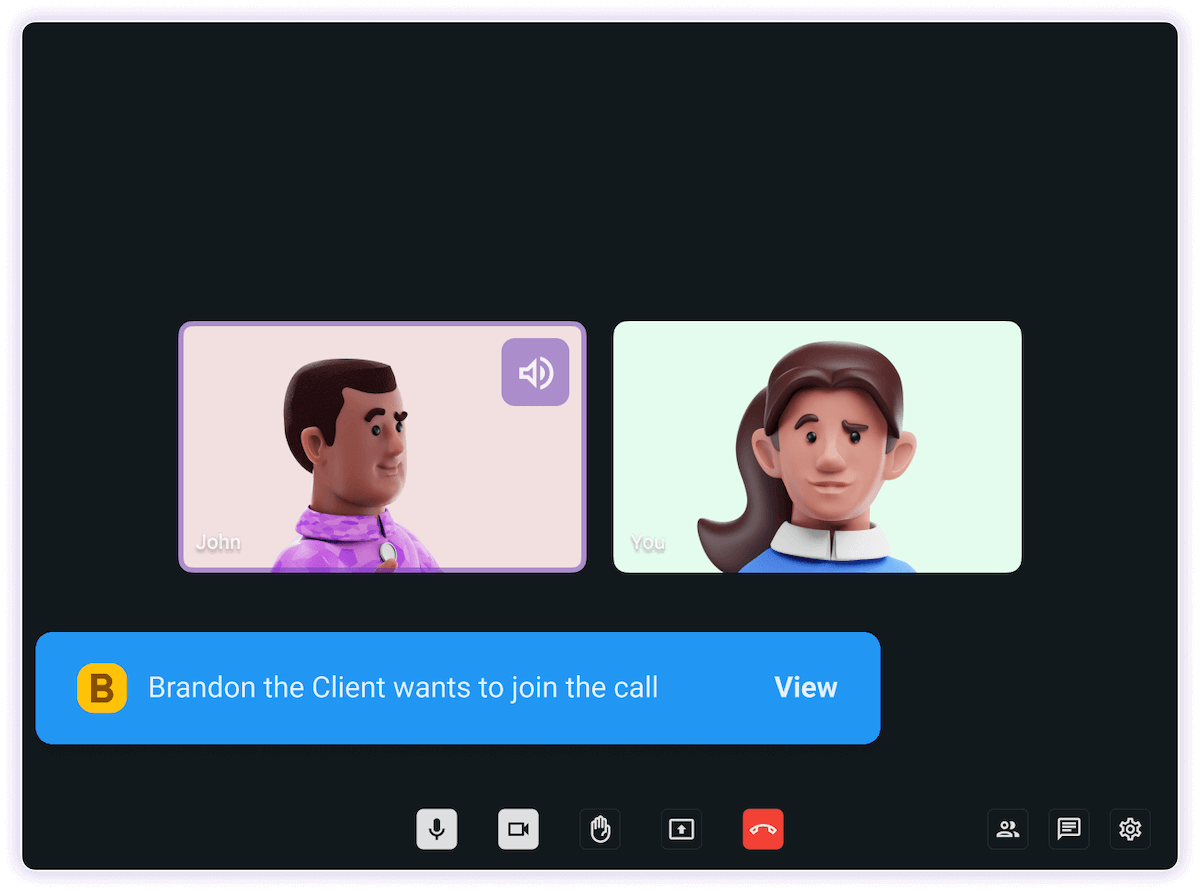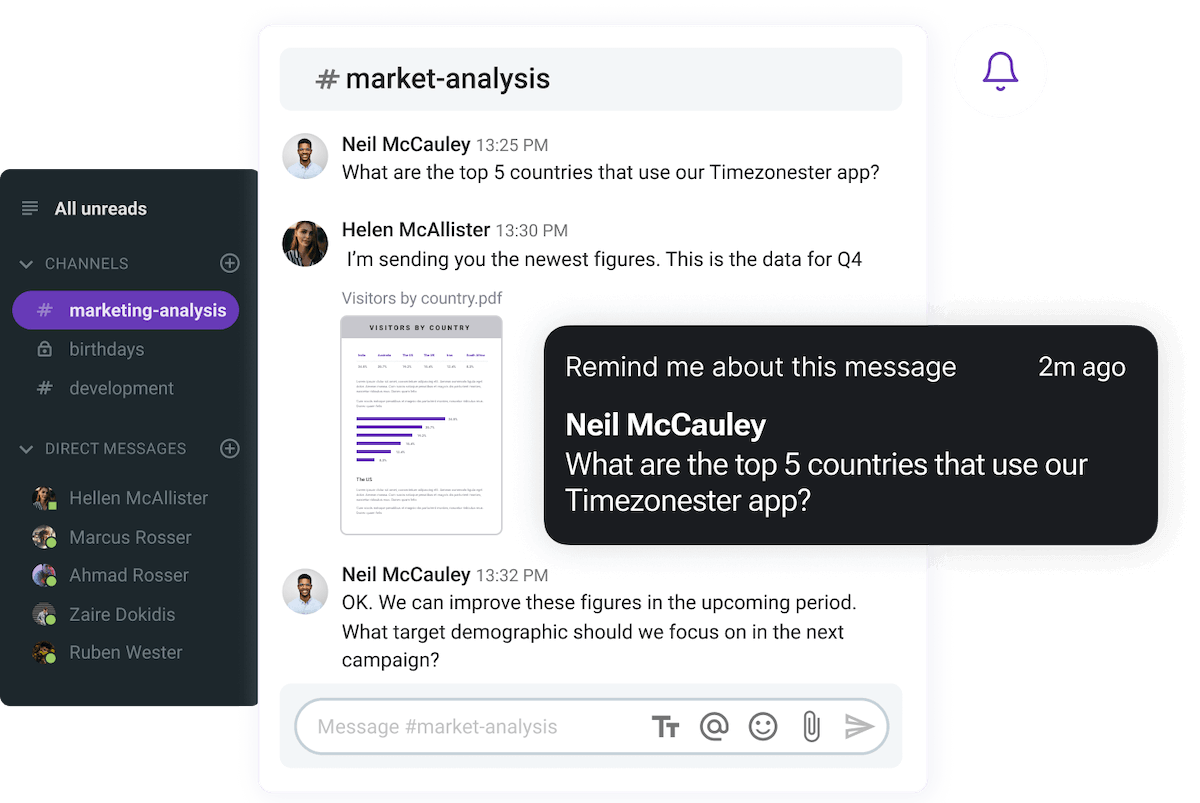Outside of situations when they’re struggling with a presentation, rarely does anyone like to be on the receiving end of a “sorry to interrupt” during a meeting.
Probably the only more awkward feeling is being the one who has to utter these words. You know you’ll immediately have all eyes on you and the pressure to provide a reasonable explanation just adds to your discomfort.
Even in the age of video conferencing tools with options to raise a (virtual) hand, it can still come across as impolite and too disruptive to interrupt people speaking in a meeting.
So, how does one gather courage and go about this politely and professionally?
Keep reading to find out:
- When it’s appropriate to interrupt someone in a meeting,
- General rules for interrupting politely in a meeting,
- Examples of how to politely interrupt in specific situations in a meeting, and
- How to prevent or minimize interruptions in meetings.
Let’s get started!

Table of Contents
General rules on how to politely interrupt in a meeting
Regardless of the reason for interrupting, you’re bound to be in a situation where you’ll need to cut in on a conversation in a meeting.
If you want to ensure as professional and as polite an approach as possible, you’d want to read the next few paragraphs carefully.
In the following lines, we’ll outline some general guidelines on how to politely interrupt that apply to all reasons and meeting scenarios.
Rule #1: Start by asking for permission to chime in
First things first, make sure to always ask for permission to interrupt.
Even if you’re absolutely positive your teammates won’t mind you jumping in, it’s only appropriate and polite to ask for everyone’s permission to interrupt first.
This way, you’re showing respect to all participants and demonstrating your awareness of basic meeting and professional communication etiquette.
Therefore, instead of cutting straight to the chase, take a second to acknowledge others and ask for their permission to chip in.
You can go with something along the lines of:
“Do you mind if I add something quickly?”
“Excuse me, but may I ask a quick question?”
Rule #2: Apologize for interrupting
Needless to say, your next step is to apologize for cutting in and cutting people off.
To interrupt politely has a lot to do with the amount of awareness shown of how it may come across and apologizing to everyone involved for chiming in.
Although it seems obvious and common sense, we’ve all witnessed numerous situations in meetings where a simple “sorry“ was missing from the vocabulary of a person interrupting, so it’s best we highlight the importance of apologizing.
If you don’t want to come across as rude and outright insensitive and get all the wrong types of attention from your coworkers, be sure to start with an apology:
“I’m terribly sorry to interrupt, but…”
“My apologies for cutting in, but…”
Rule #3: Mind the timing and the relevancy
Understanding how to politely interrupt often involves the right timing.
A good rule of thumb when determining the right time to jump in with your questions and remarks is to make sure it’s relevant to the topic or issue discussed. (Unless you need to make an urgent announcement or need to leave the meeting early due to an emergency, in which case you can’t really mind the timing.)
In other words, don’t wait until the next topic of discussion to add a comment about the current one.
At the same time, pay attention to the relevancy of your commentary — is it actually contributing to the topic, or is it derailing the conversation away from the main focus?
Rule #4: Raise your (virtual) hand
Before you jump in and potentially disrupt the flow of conversation, it’s a good practice to announce your interruption with a visual cue. Since most meetings nowadays are virtual, you could make use of the virtual hand-raising feature.
Whether you need to chime in during video or voice calls, or even during in-person meetings, it’s a good idea to start with a visual cue such as raising a hand.

Although still disruptive, a hand-raising signal can serve to remind people speaking that you have something to add and thus help you avoid verbally interrupting someone mid-sentence. This way, you are signaling that you’ll go next, after the person speaking finishes their point.
Now that we’ve established some general rules, let’s see how these apply in specific situations.
Stay polite and respectful with Pumble’s video features
How to interrupt politely in a meeting
Understanding that it might be justified to cut in during a meeting doesn’t necessarily make the process any easier. You’ll still need a few tips and some useful phrases to make the interruption polite and professional.
That’s why we’ll go over some of the most common situations when it’s appropriate to interrupt in a meeting and offer suggestions on how to execute it politely and professionally.
Scenario #1: When one person is dominating the conversation
We’ve all been there at least once in our careers. One or two people are completely absorbed into their perspective up to the point of becoming oblivious to the underlying purpose of the meeting — to hear multiple perspectives and discuss the best possible solutions.
It’s becoming clear you (or any other participant, for that matter) won’t get the opportunity to share your feedback unless someone puts a stop to the monologue/dialogue happening.
Unfortunately, this is a rather common scenario in meetings. According to the data from the latest meeting statistics, 79% of organizations across America experience this scenario in meetings, despite the fact that 64% of professionals report this behavior as their biggest meeting pet peeve. Still, data shows that 42% of respondents didn’t get a chance to express their opinion in a meeting.
So, how do you politely put a stop to this behavior?
Let’s find out.
How to politely interrupt when one person is dominating the conversation
The fact that you’re doing the right thing here doesn’t mean you should be rude or disrespectful when interrupting someone dominating the conversation in a meeting.
There’s still proper etiquette to follow to remain polite and respectful:
- Address the person by their name. This will serve to grab their attention and politely call them out on their behavior.
“Hey, Sarah, I’d like to jump in here.”
- Ask to add your point of view. Remember to remain polite and respectful while reminding the person other perspectives need to be heard.
“Sorry to interrupt, but I hope you don’t mind if I add my two cents?”
- Recap their points and add your ideas and commentary. Acknowledge their perspective and build on from there to move the conversation further and away from the person in question.
“As Sarah was saying, I think we could really benefit from [strategy name] going forward. There’s also an untapped potential in [resource name] we should look into.”
- Pass the mic. Introduce other participants and ask for their perspective.
“I’m sure Samira will have more info on that.”
Scenario #2: When the conversation gets sidetracked
Another meeting scenario we’re all familiar with is when a discussion gets off track. It takes one person and one semi-interesting but unrelated remark to turn the entire direction of the conversation.
This scenario is mostly present in meetings that lack:
- Clear direction,
- Purpose,
- A detailed agenda, or
- A meeting facilitator to keep the conversation on track.
How to politely interrupt when the conversation gets sidetracked
No matter how hopeless this situation may seem, all is not lost. There’s still a way to turn the unfocused conversation into an effective and productive meeting.
The trick is to act fast and nip the side conversation in the bud — i.e., to interrupt it, politely.
Here’s what you can do to politely interrupt and steer the conversation back on track.
- Stop the momentum. You can either raise your (virtual) hand to announce you’re about to speak or jump in unannounced. Whichever approach you decide to take, don’t forget to apologize first. Also, a great option here is to again mention the speaker(s) by their name to really grab their attention.
- Remain professional and polite. Don’t forget to ask for permission to jump in and apologize for interrupting.
“Excuse me, but may I cut in here?”
“I’m so sorry to interrupt. If it’s OK I’d like to take it from here?”
“Apologies for interrupting, but may I just chime in quickly?”
- Get the conversation back on track. Now it’s time to acknowledge the person speaking and thank them for their insights while steering the conversation back to the main agenda.
“Great points, Michelle. Let’s revisit those in our next week’s meeting, as we have just enough time to go over our priorities for this week.”
Scenario #3: When you want to make a relevant contribution to a conversation
Our next scenario is probably one of the most common examples of interruptions in meetings. We’ve all witnessed a situation where one person jumps in to deliver their opinion on a topic of discussion.
And, most likely, some of those interruptions were highly inappropriate and uncalled for, while others were perfectly reasonable.
If you’re unsure of whether or not to interrupt a conversation in a meeting and add your two cents, ask yourself whether what you have to say is relevant and brings real value to the conversation, or if there might be a better time in the meeting to share your ideas.
For example, if the topic is about to be closed and you have a relevant piece of information that could resolve an issue, then it’s perfectly reasonable to jump in.
On the other hand, if the topic is still on the table, and everyone involved gets to share their opinion, it might be better to wait your turn.
How to politely interrupt when you want to make a timely and relevant contribution to a conversation
When you’ve assessed that it’s reasonable to chime in and share your opinion, it’s still important to be mindful of how you’re wording your ideas.
Here are some phrases you can use to cut in when you want to share your opinion in a meeting politely and professionally:
“I hate to interrupt, but may I just add something before we move on?”
“If it’s OK, I’ll just share something I believe is relevant to this issue while we’re on that topic.”
Scenario #4: When you need to ask a question or need clarification
Ever contemplated whether to jump in to ask a question during a particularly unclear presentation in a meeting? Well, our verdict here is clear — it is perfectly reasonable to do so. Of course, as long as you’re being polite and respectful.
In addition to clearing any confusion and helping yourself better understand and engage with what’s discussed in a meeting, you’re potentially also helping others who may have the same problem. So, we say — go for it. And here’s how.
How to politely interrupt when you need to ask a question or need a clarification
The general rules of politeness apply in this situation as well.
- You should always start by apologizing for interrupting and asking for permission to chime in. There are plenty of ways to politely apologize for interrupting, as you’ve seen in the examples provided above — so, feel free to use any of those, or come up with your own.
- Next up, it’s time to cut straight to the chase and ask your question(s). It’s important to be brief and to the point so as not to disrupt the flow of the meeting any more than it’s completely necessary.
- Moreover, remember not to put the responsibility on the person speaking. Own your confusion, lack of information, or preparation, and help the person helping you.
- Finally, to improve the efficiency of the exchange, you can rephrase what the person was saying to help them understand what part you need more clarity on.
To do all of that, you can use one of the following examples:
“Hate to be rude, but may I ask a quick question?”
“Would you mind explaining the last part to me again?”
“If I understand you correctly, you’re suggesting we start creating Affiliate marketing and Partnership sales channels in hopes of getting more revenue through partnerships? Do we have a team assigned for this, or are we thinking about hiring new people?”
Scenario #5: When you want to help someone who is struggling in a meeting
Great team spirit and connection rely on lending a helping hand when other team members experience challenges.
If you notice any of the following scenarios during a team meeting, it might be time to interrupt and offer help:
- A team member is experiencing technical difficulties.
- A coworker is struggling to answer a question because they’re missing relevant information.
- Someone is experiencing extreme meeting anxiety.
How to politely interrupt when you want to help someone who is struggling in a meeting
The trick with jumping in to offer help in situations where a colleague is struggling in a meeting is to know when your help is actually needed, welcome, and appreciated. Otherwise, it can be completely counterproductive as you can overstep people’s boundaries and you can seem completely out of touch with a situation.
Sure, you want to help keep the meetings as interactive, engaging, and effective as possible, but it’s important to stay cognizant of personal and professional boundaries as you’re doing so.
For example, you might say:
“Can I interrupt for a moment? Sorry for cutting in, but I had the same issue recently, so maybe you could try this approach…”
“I don’t mean to intrude, but this reminded me we need to add something here…”
“Excuse me for butting in. Just wanted to say that I think that’s great/interesting…”
💡 Pumble Pro Tip
Understanding and properly assessing the right moment to jump in and help out a colleague struggling in a meeting requires a great deal of awareness and emotional intelligence. To perfect these skills, be sure to check out our blog post on the topic:
Scenario #6: When you need to deliver an urgent message or update
Unpredictable situations are bound to happen during meetings, and some of those require your immediate reaction. This means that you’ll have to interrupt an important discussion once in a while to, for example:
- Leave a meeting due to a family emergency, or
- Deliver an important update that just came up.
Luckily, there are some useful phrases you can use to politely interrupt a meeting to deliver your message.
How to politely interrupt when you need to deliver an urgent message or update
Even though these unexpected situations are, well, unanticipated, you can still choose how you’ll deliver them.
When you need to leave the meeting for some reason, or you received an important update from a client or another teammate that could change the direction of the discussion or resolve an issue, you’ll inevitably need to interrupt an ongoing conversation. However, you can still choose your words carefully to remain polite and professional.
Here’s what that can look like:
“So sorry to interrupt, but I’ll have to leave the meeting due to a family emergency.”
“Hope you don’t mind me barging in, but I just heard from the X client, and I have some great news regarding this project.”
How to prevent/minimize interruptions in meetings
In most cases, interruptions are inevitable. Things come up, people need explanations, and accidents happen.
That being said, there are still some ways you can reduce or prevent potential interruptions in meetings.
Let’s go over our top tips on how to interrupt-proof your meetings and create a more productive meeting experience.
Tip #1: Assign a meeting facilitator
When looking to improve the quality of your work meetings, whether they are virtual or in-person, one of the key steps you should take is defining clear meeting roles.
In addition to fostering inclusivity, collaboration, and productivity, assigning the right people for relevant meeting roles can reduce misunderstandings and interruptions and improve the overall flow of your meetings.
When people are aware of who’s in charge of what, they are less likely to take it upon themselves to intervene when it’s not their turn to speak.
Moreover, when meeting roles are assigned and communicated to all participants before the meeting, there’s less opportunity for one or two people to dominate the entire conversation.
The tech host or a chat moderator, for example, can ensure any tech issues are addressed in a timely manner without having to interrupt the ongoing conversation.
At the same time, a meeting facilitator can serve as a powerful figure in maintaining an undisrupted and effective conversation. A skilled facilitator can anticipate and prevent potential side conversations and group conflicts. By setting the tone from the start, meeting facilitators also can help avoid potential miscommunication.
Simply put, consider assigning clear meeting roles to minimize interruptions in meetings.
Maintain undisrupted and effective communication — host your meetings in Pumble
Tip #2: Create a detailed meeting agenda
Similarly, a detailed meeting agenda can provide clear guidelines on the purpose and the flow of the meeting.
When participants are aware of the talking points and action items, they are more likely to stick to the predetermined schedule and prioritize the main points.
Moreover, the meeting agenda provides an insight into who’s in charge of what, which clears any potential confusion and minimizes the risk of conversations going on a tangent.
💡 Pumble Pro Tip
If you’re not sure where to start with a meeting agenda for your virtual meetings, we have a guide on the blog. Check it out and learn how to design an effective virtual agenda that will keep your meetings productive and your participants engaged:
Tip #3: Set ground rules at the beginning
One of the best ways to avoid unnecessary interruptions during meetings is to set some ground rules at the beginning.
It’s hard to determine whether the speakers would prefer to have someone jump in and take over from time to time or if they’d like to have an undisrupted presentation and address the questions later on.
So, it’s best to ask before the formal part of the meeting so that everyone is in on the preferred approach.
However, if there are no official speakers at the meeting and everyone is welcome to join, then it’s best to suggest how the questions and remarks will be handled. You can do a quick poll and vote to get a better understanding of how the participants feel about interruptions.
In general, it’s a good practice to establish a couple of universal rules regarding:
- Visual cues when someone wants to chime in (e.g. hand-raising),
- Preferred time to answer questions, and
- Rules of conduct in case of an emergency or urgent update.
Having all participants agree on the rules and cues about interruptions and questions at the beginning of a meeting will help you reduce unwanted interruptions during the meeting and ensure a more pleasant and effective meeting experience.
Pumble makes your meetings more effective — Even with interruptions
As you have seen above, you should interrupt others only when there is a clear reason to do so. Otherwise, you’re really diminishing the effectiveness of the meetings you attend (not to mention prolonging them).
To ensure your remote meetings remain as effective as possible, hold them over Pumble, a team communication app.
Thanks to some of its features, Pumble can help you keep your interruptions minimally disruptive and as polite as possible.
For exmaple, you can politely interrupt the speaker while you are on a video call by raising a (virtual) hand. Of course, it is up to you to follow the guidelines mentioned above and choose the right time for that action.
And, if you want to make a side note that’s not really worth interrupting, you can send an in-call message.

But it’s not just face-to-face meetings that you have to worry about impolite interruptions — it’s written conversations, as well.
Luckily, Pumble offers a solution for that as well. For example, if there is an ongoing conversation in one of the company channels, try not to interrupt it by adding newposts. Instead, use the thread conversation feature.
Naturally, we won’t always be in a position to voice our opinions and thoughts when it suits us — as we already established, there’s a time and place for interruptions. That’s why Pumble has a handy feature — reminders — that will, as their name suggests, remind you to ask what you want when the right time comes.







